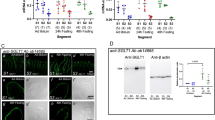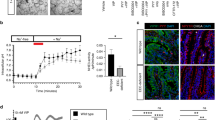Abstract
ACTIVELY transported sugars added to the solution bathing the mucosal surface of the small intestine produce an increase in the electrical potential difference (p.d.) and short-circuit current (Isc) across the tissue1–4. Schultz and Zalusky1 have shown that the increase in the Isc (ΔIsc) across rabbit ileum is a function of both sugar and sodium concentrations in the bathing solution. When sodium was replaced with potassium, the maximum ΔIsc caused by addition of sugars was a linear function of sodium concentration. Recently, Barry et al.5 reported that the increase in the p.d. (Δp.d.) following addition of galactose to the mucosal bathing solution of everted sacs of rat mid-intestine is independent of sodium concentration when mannitol is used to replace sodium chloride, but is approximately a linear function of sodium concentration when potassium is used to replace sodium. They have concluded that the “galactose dependent potential is unaffected by sodium concentration but is reduced by increasing potassium concentration”. Lyon and Crane6 have reported that, in rat jejunum, the maximum Δp.d. resulting from addition of actively transported sugars is independent of sodium concentration when tris [2-amino-2(hydroxymethyl)-1,3-propanediol] is used to replace sodium, but decreases when potassium is used as replacement ion.
This is a preview of subscription content, access via your institution
Access options
Subscribe to this journal
Receive 51 print issues and online access
$199.00 per year
only $3.90 per issue
Buy this article
- Purchase on Springer Link
- Instant access to full article PDF
Prices may be subject to local taxes which are calculated during checkout
Similar content being viewed by others
References
Schultz, S. G., and Zalusky, R., J. Gen. Physiol., 47, 1043 (1964).
Barry, R. J. C., Dikstein, S., Matthews, J., Smyth, D. H., and Wright, E. M., J. Physiol., 171, 316 (1964).
Barry, R. J. C., Smyth, D. H., and Wright, E. M., J. Physiol., 181, 410 (1965).
Asano, T., Proc. Soc. Exp. Biol. and Med., 119, 189 (1965).
Barry, R. J. C., Eggenton, J., Smyth, D. H., and Wright, E. M., J. Physiol., 182, 40 P (1966).
Lyon, I., and Crane, R. K., Biochim. Biophys. Acta, 112, 278 (1966).
Schultz, S. G., and Zalusky, R., J. Gen. Physiol., 47, 567 (1964).
Asano, T., Amer. J. Physiol., 207, 415 (1964).
Schultz, S. G., Zalusky, R., and Gass, jun., A. E., J. Gen. Physiol., 48, 375 (1964).
Author information
Authors and Affiliations
Rights and permissions
About this article
Cite this article
SCHULTZ, S., CURRAN, P. & WRIGHT, E. Interpretation of Hexose-dependent Electrical Potential Differences in Small Intestine. Nature 214, 509–510 (1967). https://doi.org/10.1038/214509a0
Published:
Issue Date:
DOI: https://doi.org/10.1038/214509a0
This article is cited by
-
A mechanistic explanation of the effect of potassium on goldfish intestinal transport
Pfl�gers Archiv European Journal of Physiology (1979)
-
The mechanism of anion permeation in thorium-treated gallbladder
The Journal of Membrane Biology (1972)
-
Transmural potential difference (PD) in the body of the esophagus in patients with esophagitis, Barrett's epithelium and carcinoma of the esophagus
The American Journal of Digestive Diseases (1971)
-
The mechanism of cation permeation in rabbit gallbladder
The Journal of Membrane Biology (1971)
-
The mechanism of cation permeation in rabbit gallbladder
The Journal of Membrane Biology (1971)
Comments
By submitting a comment you agree to abide by our Terms and Community Guidelines. If you find something abusive or that does not comply with our terms or guidelines please flag it as inappropriate.



